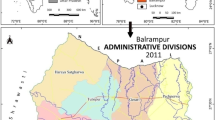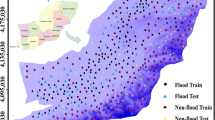Abstract
In Romania, as in the rest of the world, the flood frequency has increased considerably. Prahova river basin is among the most exposed catchments of the country to flood risk. It also represents the area of the present study for which the identification of surfaces with high susceptibility to flood phenomena was attempted by applying 2 hybrid models (adaptive neuro-fuzzy inference system and fuzzy support vector machine hybrid) and 2 bivariate statistical models (certainty factor and statistical index). The computation of Flood Potential Index (FPI) was possible by considering a number of 10 flood conditioning factors together with a number of 158 flood pixels and 158 non-flood pixels. Generally, the high and very high flood potential appears on around 25% of the upper and middle basin of Prahova river. The validation of the results was made through the ROC Curve model. One of the novelties of this research is related to the application of Fuzzy Support Vector Machine ensemble for the first time in a study concerning the evaluation of the susceptibility to a certain natural hazard.







Similar content being viewed by others
References
Blanco-Vogt A, Schanze J (2014) Assessment of the physical flood susceptibility of buildings on a large scale–conceptual and methodological frameworks. Nat Hazards Earth Syst Sci 14(8):2105–2117
Cao C, Xu P, Wang Y, Chen J, Zheng L, Niu C (2016) Flash flood hazard susceptibility mapping using frequency ratio and statistical index methods in coalmine subsidence areas. Sustainability 8(9):948
Celikyilmaz A, Turksen IB (2009) Modeling uncertainty with fuzzy logic. Stud Fuzziness Soft Comput 240:149–215
Chang C, Lin C (2011) LIBSVM: a library for support vector machines. ACM Trans Intell Syst Technol 2(3):1–27
Chapi K, Singh VP, Shirzadi A, Shahabi H, Bui DT, Pham BT, Khosravi K (2017) A novel hybrid artificial intelligence approach for flood susceptibility assessment. Environ Model Softw 95:229–245
Costache R (2019) Flash-flood potential assessment in the upper and middle sector of Prahova river catchment (Romania). A comparative approach between four hybrid models. Sci Total Environ 659:1115–1134
Costache R, Zaharia L (2017) Flash-flood potential assessment and mapping by integrating the weights-of-evidence and frequency ratio statistical methods in GIS environment–case study: Bâsca Chiojdului River catchment (Romania). J Earth Syst Sci 126(4):59
Fotovatikhah F, Herrera M, Shamshirband S, Chau KW, Faizollahzadeh Ardabili S, Piran MJ (2018) Survey of computational intelligence as basis to big flood management: challenges, research directions and future work. Eng Applic Comput Fluid Mech 12(1):411–437
Ilia I, Koumantakis I, Rozos D, Koukis G, Tsangaratos P (2015) A geographical information system (GIS) based probabilistic certainty factor approach in assessing landslide susceptibility: the case study of Kimi, Euboea, Greece. Engineering geology for society and territory-volume 2 (pp. 1199–1204). Springer, Cham
Jang JS (1993) ANFIS: adaptive-network-based fuzzy inference system. IEEE Trans Syst Man Cybernet 23(3):665–685
Khan A, Baharudin B, Lee LH, Khan K (2010) A review of machine learning algorithms for text-documents classification. J Adv Inform Technol 1(1):4–20
Khosravi K, Nohani E, Maroufinia E, Pourghasemi HR (2016) A GIS-based flood susceptibility assessment and its mapping in Iran: a comparison between frequency ratio and weights-of-evidence bivariate statistical models with multi-criteria decision-making technique. Nat Hazards 83(2):947–987
Lin CF, Wang SD (2002) Fuzzy support vector machines. IEEE Trans Neural Netw 13(2):464–471
Maiti S, Tiwari RK (2014) A comparative study of artificial neural networks, Bayesian neural networks and adaptive neuro-fuzzy inference system in groundwater level prediction. Environ Earth Sci 71(7):3147–3160
Oh HJ, Pradhan B (2011) Application of a neuro-fuzzy model to landslide-susceptibility mapping for shallow landslides in a tropical hilly area. Comput Geosci 37(9):1264–1276
Pradhan B, Lee S, Buchroithner MF (2009) Use of geospatial data and fuzzy algebraic operators to landslide-hazard mapping. Appl Geomat 1(1–2):3–15
Rahmati O, Pourghasemi HR, Zeinivand H (2016) Flood susceptibility mapping using frequency ratio and weights-of-evidence models in the Golastan Province, Iran. Geocarto Int 31(1):42–70
Rahmati O, Pourghasemi HR (2017) Identification of critical flood prone areas in data-scarce and ungauged regions: a comparison of three data mining models. Water Resour Manag 31(5):1473–1487
Shafizadeh-Moghadam H, Valavi R, Shahabi H, Chapi K, Shirzadi A (2018) Novel forecasting approaches using combination of machine learning and statistical models for flood susceptibility mapping. J Environ Manag 217:1–11
Tehrany MS, Pradhan B, Jebur MN (2014) Flood susceptibility mapping using a novel ensemble weights-of-evidence and support vector machine models in GIS. J Hydrol 512:332–343
Tehrany MS, Pradhan B, Mansor S, Ahmad N (2015) Flood susceptibility assessment using GIS-based support vector machine model with different kernel types. Catena 125:91–101
Vormoor K, Lawrence D, Heistermann M, Bronstert A (2015) Climate change impacts on the seasonality and generation processes of floods–projections and uncertainties for catchments with mixed snowmelt/rainfall regimes. Hydrol Earth Syst Sci 19(2):913–931
Wang YM, Elhag TM (2008) An adaptive neuro-fuzzy inference system for bridge risk assessment. Expert Syst Appl 34(4):3099–3106
Xian GM (2010) An identification method of malignant and benign liver tumors from ultrasonography based on GLCM texture features and fuzzy SVM. Expert Syst Appl 37(10):6737–6741
Xu C, Dai FC, Yao X, Chen J, Tu XB, Cao YB, Xiao JZ (2010) GIS based certainty factor analysis of landslide triggering factors in Wenchuan earthquake. Chin J Rock Mech Eng 29(Z1):2972–2981
Zaharia L, Costache R, Prăvălie R, Ioana-Toroimac G (2017) Mapping flood and flooding potential indices: a methodological approach to identifying areas susceptible to flood and flooding risk. Case study: the Prahova catchment (Romania). Front Earth Sci 11(2):229–247
Acknowledgements
The author would like to thank to the editors and the three anonymous reviewers of the Water Resources Management journal, for their critical and valuable comments that helped to bring the manuscript into its present form. This paper was financially supported by the Research Institute of the University of Bucharest.
Author information
Authors and Affiliations
Corresponding author
Ethics declarations
Conflict of Interest
None.
Additional information
Publisher’s Note
Springer Nature remains neutral with regard to jurisdictional claims in published maps and institutional affiliations.
Rights and permissions
About this article
Cite this article
Costache, R. Flood Susceptibility Assessment by Using Bivariate Statistics and Machine Learning Models - A Useful Tool for Flood Risk Management. Water Resour Manage 33, 3239–3256 (2019). https://doi.org/10.1007/s11269-019-02301-z
Received:
Accepted:
Published:
Issue Date:
DOI: https://doi.org/10.1007/s11269-019-02301-z




